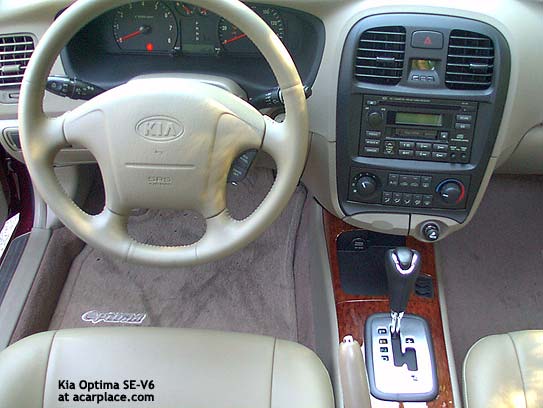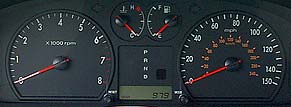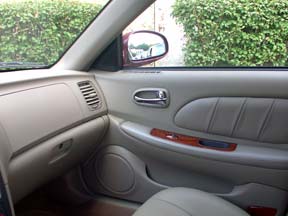
| Review Notes: 2002 Kia Optima SE V6 | |
| Personality | Luxury sedan, minus the gadgets |
| Quirks | Strange window lockout and power locks |
| Gas mileage | 19 city, 25 highway |
| Unusual features | SE/V6 luxury cues don't match the sticker price; SportMatic transmission |
| Above Average | Ride, overall feel, price, warranty |
| Needs Work In | Gas mileage, sales and marketing |
| Bottom-scraper test | Passed |
| Car reviews written by | David Zatz |
The Kia Optima must have frightened many executives when it first came out. Easily more comfortable, quiet, and responsive than the top-selling Honda Accord (the second best selling car in America, in most recent years), the Optima carries the best powertrain warranty in America along with a moderately low price tag. What's more, because Kia has no luxury marque, the designers feel free to make the Optima look like a luxury sedan, inside and out. Our test model had the standard, tasteful chrome exterior touches - on the door handles, for example - as well as a classy leather, chrome, and and faux wood interior which ranks up there with true luxury sedans - except for those it beats. All that comes for around $16,000 to $20,000, which is Accord territory - and below the Dodge Stratus, Chevy Impala, and Ford Taurus by quite a bit.
Our Optima had a V6 engine coupled to a well-designed manumatic, a transmission which lets you decide whether to shift the gears yourself (well, at least it lets you tell the automatic transmission when to shift, as long as you don't tell it to do something foolish). A manumatic really isn't necessary in the Optima, because the automatic is so well-tuned that you'll probably never bother shifting yourself, except out of curiosity. Still, if you're going to do a manumatic you should do it well, and Kia did. Unlike the most popular manumatic - the Chrysler AutoStick - the Kia's "SportMatic" is very simple to slap around. There are no annoying gates, just a single slide down to D, and then if you want to shift yourself, slap it over to the right; then a slap up or down will change gears. Chrysler has the manumatic mode just below D, so it requires a little more care to go in and out of automatic mode, and Chrysler also has you go side-to-side to change gears - not quite as convenient. But, as we said, you probably won't care most of the time. We found the transmission smoothly and silently gliding into the right gear, without hesitation or fuss. Our only complaint is that the automatic tends to hestitate before upshifting when you let off the gas, and that's probably by design - then you're still given an acceleration gearing for a few seconds after you start to coast. It's hardly noticeable unless you're looking for an excuse to take control over the gearbox.

A side benefit of the SportMatic, which is available on both the LX and SE models, is the ability to start out in second gear, which can be handy on snow or mud.
The optional 178 horse V6 compares favorably to competitors' engines, which while of similar or greater power tend to have heavier vehicles to push around. The base engine is a 149 horsepower 2.4 liter engine with dual cams, making almost the same power as the Mitsubishi and Chrysler engines of the same displacement, and providing enough power for most people. (Chrysler, Hyundai, Kia, and Mitsubishi will all share four cylinder engines in vehicles introduced after 2003.) Both the four and the six are classified as Transitional Low Emissions Vehicles.
 The interior includes a generic instrument panel with a large speedometer and odometer, and smaller heat and fuel gauges. The transmission gear display is standard until you use the SportMatic's semiautomatic mode - then it also displays the gear you're currently in (1, 2, 3, or 4). Most of the controls are easy to use and have a quality feel, the feel noted on Japanese cars and ignored on Korean and American cars. There aren't many things that feel cheap, other than the cruise control buttons. For the most part, the standards are quite high.
The interior includes a generic instrument panel with a large speedometer and odometer, and smaller heat and fuel gauges. The transmission gear display is standard until you use the SportMatic's semiautomatic mode - then it also displays the gear you're currently in (1, 2, 3, or 4). Most of the controls are easy to use and have a quality feel, the feel noted on Japanese cars and ignored on Korean and American cars. There aren't many things that feel cheap, other than the cruise control buttons. For the most part, the standards are quite high.
The handbrake, like the transmission control, seems to have been designed with driver convenience in mind. Our gripes about this, as well as other Kias, remains the window controls and power locks. The window lockout, so helpful when children are in the back seat, affects the driver's controls as well as the passengers', a silly arrangement. The driver's lock locks all the doors at once, but does not unlock them - that requires a separate switch which is only on the driver's door. Likewise, the remote lock/unlock feature works on all four doors at once, no exceptions (see our gripes). On the other hand, it is built into the key - so there's no clunky key fob to carry around, only an oversized key.
The SE V6 model includes the classy trim - brushed aluminum gearshift cover, tastefully applied woodgrain trim, chrome door handles, leather steering wheel, and that sort of thing. Some of these are available on the LX V6 or SE four-cylinder as well.
 The stereos on early Kias were too small to be convenient, a problem perhaps overcompensated for in the Optima. Our test model had a stereo-CD player, with knobs to make setting volume and other audio adjustments easy, and large buttons for ease of use while driving (or wearing gloves). Likewise, the matching climate control had easy to understand, easy to use, pleasant-feel buttons, with large knobs for the fan and mix. The system is quiet even at high fan speeds, with good airflow, besting vehicles costing a great deal more. Using the air conditioner does not affect performance much, but it is not the most powerful system - more a match for Toyota and Honda than for more-effective GM and Chrysler systems.
The stereos on early Kias were too small to be convenient, a problem perhaps overcompensated for in the Optima. Our test model had a stereo-CD player, with knobs to make setting volume and other audio adjustments easy, and large buttons for ease of use while driving (or wearing gloves). Likewise, the matching climate control had easy to understand, easy to use, pleasant-feel buttons, with large knobs for the fan and mix. The system is quiet even at high fan speeds, with good airflow, besting vehicles costing a great deal more. Using the air conditioner does not affect performance much, but it is not the most powerful system - more a match for Toyota and Honda than for more-effective GM and Chrysler systems.
Air conditioning is, since we're on the subject, standard, along with tilt steering, six speaker stereo with good separation, power windows, and power locks. The SE adds keyless entry, an alarm, a power driver's seat, and a power moonroof with separate tilt and open/close controls.
Storage spaces abound, with a convenient rubber-lined area under the center stack, map pockets on both front doors and the backs of both front seats, and a dual-level center console which is easy to open on either level - and features a removable lower bin for easy cleaning (and access to the gearshift cables). Deep cupholders rest under a cover in the center console.
Rear passengers also have amenities, with a center console containing deep dual cupholders and a padded storage area. The console doubles as a trunk pass-through, when a second barrier is pulled down. The rear seats also fold down for more storage space - not that owners will need it very often. The Optima has a surprisingly large trunk.
Evaluations of safety will be left with NHTSA, but we will note that the Optima includes side airbags, and its implementation of the new LATCH child seat system works well. A first aid kit is also included, though antilock brakes are only available on V6 models. Headlights are very effective, and the interior lighting at night is a quiet, uninstrusive light green.
So much for amenities and styling - what about the feel? Well, the smooth, responsive drivetrain certainly evokes luxury and sophistication - but so does the ride. The Optima gently and quietly deals with major road imperfections with surprising smoothness, while providing good if not outstanding handling. The average driver will not squeal the tires, while those seeking a sports car should probably look elsewhere. In all, the Optima outdoes most vehicles in its class in both ride and handling.
Given our past experiences in Korean vehicles, we were very surprised by the sophistication and apparent quality of the Kia Optima. Not for nothing does it have a standard ten year (or 100,000 miles - which most people reach in about 8 years) powertrain warranty, or, for that matter, rapidly rising sales. We'd take an Optima over an Accord, any Accord, any day. The ride is far superior, the engine seems far more capable, the transmission is smoother and better at being in the right gear, and the overall feel is more pleasant and upscale. The Optima also seems lighter to drive than the Dodge Stratus and Pontiac Grand Am, and much more "adult" and luxurious than the Ford Focus. In short, Kia's hit the nail right on the head, and there's something wrong if the Optima doesn't sell like hotcakes.